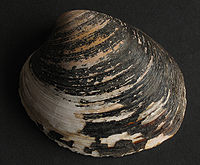
Arctica islandica
Encyclopedia

Hard clam
The hard clam , also known as a quahog , round clam, or hard-shell clam, is an edible marine bivalve mollusk which is native to the eastern shores of North America, from Prince Edward Island to the Yucatán Peninsula...
, is an edible marine
Marine (ocean)
Marine is an umbrella term. As an adjective it is usually applicable to things relating to the sea or ocean, such as marine biology, marine ecology and marine geology...
bivalve
Bivalvia
Bivalvia is a taxonomic class of marine and freshwater molluscs. This class includes clams, oysters, mussels, scallops, and many other families of molluscs that have two hinged shells...
mollusk
Mollusca
The Mollusca , common name molluscs or mollusksSpelled mollusks in the USA, see reasons given in Rosenberg's ; for the spelling mollusc see the reasons given by , is a large phylum of invertebrate animals. There are around 85,000 recognized extant species of molluscs. Mollusca is the largest...
native to the North Atlantic ocean, which is harvested commercially. This species is also known by a number of different common name
Common name
A common name of a taxon or organism is a name in general use within a community; it is often contrasted with the scientific name for the same organism...
s, including Icelandic cyprine, mahogany clam, mahogany quahog, black quahog, and black clam.
The typical Arctica islandica resembles the quahog, but the shell of the ocean quahog is rounder, the periostracum is usually black, and on the interior of the shell, the pallial line has no indentation, or sinus. Unlike the quahog, which lives intertidally and can be collected by clam digging
Clam digging
Clam digging is a common means of harvesting clams from below the surface of the tidal mud flats where they live. It is done both recreationally and commercially...
, this species lives subtidally, and can only be collected by dredging. They grow to sizes exceeding 50 mm shell height.
These animals show exceptional longevity and have been estimated to live up to 400 years in the wild. In 1868 one specimen, collected alive near Iceland
Iceland
Iceland , described as the Republic of Iceland, is a Nordic and European island country in the North Atlantic Ocean, on the Mid-Atlantic Ridge. Iceland also refers to the main island of the country, which contains almost all the population and almost all the land area. The country has a population...
, was 374 years old. The study of its growth rate and the oxygen isotope data showed that it had a highly variable growth at the peak of the Little Ice Age
Little Ice Age
The Little Ice Age was a period of cooling that occurred after the Medieval Warm Period . While not a true ice age, the term was introduced into the scientific literature by François E. Matthes in 1939...
around 1550-1620 and mild climate near its end around 1765-1780 and had recorded the volcanic eruption of Mount Tambora
Mount Tambora
Mount Tambora is an active stratovolcano, also known as a composite volcano, on the island of Sumbawa, Indonesia. Sumbawa is flanked both to the north and south by oceanic crust, and Tambora was formed by the active subduction zone beneath it. This raised Mount Tambora as high as , making it...
in 1815. One study found that in animals aged 4–192 years, antioxidant enzymes declined rapidly in the first 25 years, which includes the growth and sexual maturity stages, but afterwards remained stable for over 150 years. Though more detailed studies are warranted, it appears this species is a case of negligible senescence
Senescence
Senescence or biological aging is the change in the biology of an organism as it ages after its maturity. Such changes range from those affecting its cells and their function to those affecting the whole organism...
.

